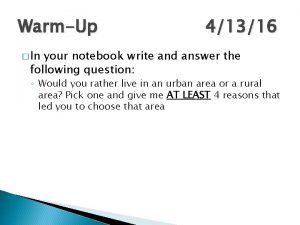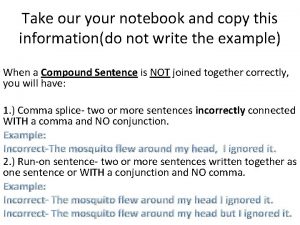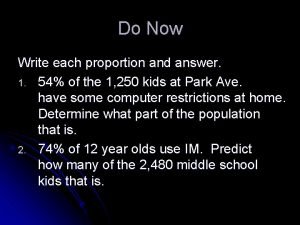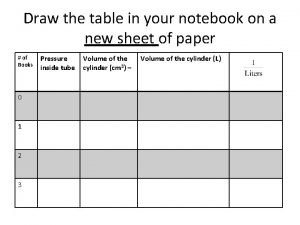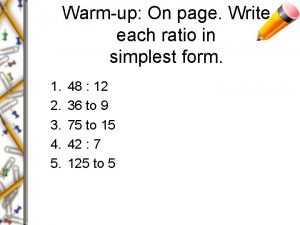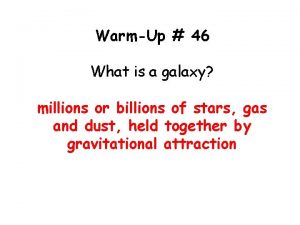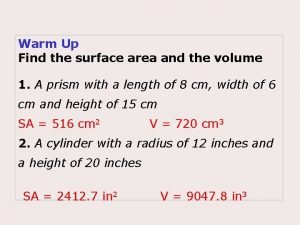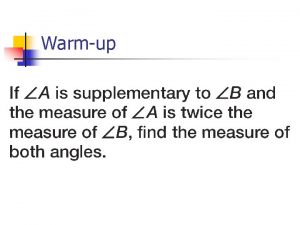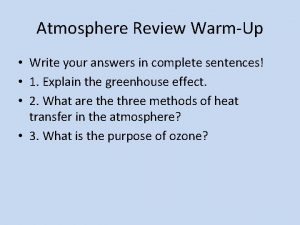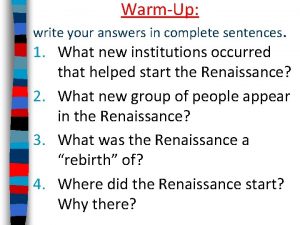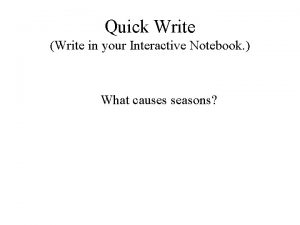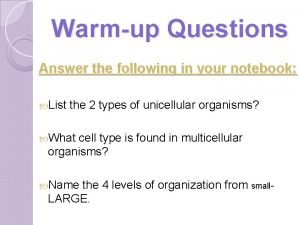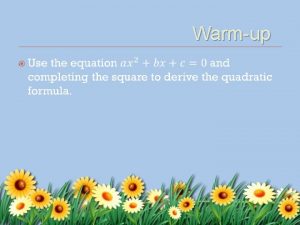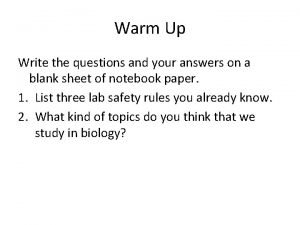WarmUp Write questions and answers in your notebook

Warm-Up Write questions and answers in your notebook 1. Why do we have climate zones? 2. What is the different between weather and climate? 3. Can pollution change a climate? 4. What do you expect to learn from this unit?

1. As latitude increases, the intensity of solar radiation _________. A. B. C. D. increases decreases stays the same fluctuates

2. What effect does elevation have on climate? A. As elevation increases, the climate becomes warmer. B. As elevation increases, the climate becomes colder. C. As elevation decreases, the climate becomes colder. D. Elevation has no effect on climate.

3. In which way(s) do humans affect global warming? A. B. C. D. deforestation agriculture burning fossil fuels all of the above

4. What process naturally warms Earth to a temperature suitable for life? A. dew point B. global warming C. climate change D. greenhouse effect

5. Volcanic eruptions typically make the nearby climate have a _______ temperature. A. warmer B. cooler

6. Solar activity typically ______ temperature. A. B. C. D. increases decreases stabilizes does nothing to

7. What do global winds (atmospheric circulation) do to change climate? a. move moisture around the world b. move heat around the world c. they do nothing to change climate d. both a and b

8. Water in the ocean forms layers based on density, higher-density water occurs where? A. Above low-density water B. Below low-density water C. There are no layers in ocean water

9. Water temperature in the ocean is COLDEST in which layer? A. Deep Water Layer B. Thermocline C. Mixed Layer D. It’s all the same temperature

10. Which of these factors does NOT impact weather and climate? A. Volcanic Eruptions B. Greenhouse Effect C. El Niño/ La Niña D. Jupiter

Directions: Answer either true or false. 1. ___ Even without pollution, climate can change by itself. 2. ___ El Niño is when the Pacific Ocean is much warmer than usual. 3. ____ Pollution can change climate. 4. ______ Scientists don't think that global warming is happening. 5. _______Sunlight is important in making climate. 6. ____ Recycling helps to not change climate by mistake. 7. ____ Climates can change in a few weeks. 8. El Niño is a good thing for some places on Earth. 9. Volcanoes can change climate with their smoke. 10. _______Water is important in making climate. Weather Smart: Climate Video Quiz

Draw This In Your Notebook Word What it Means Weather What is happening in the atmosphere right now (hot or cold, raining or dry, etc. ) Climate Weather over the span of millions of years, the statistics of rain, wind, sunlight and everything over long periods of time Climate Change Significant and lasting changes to weather patterns over long periods of time (how average weather, known as climate, changes over periods of time)

What are ways climate change is affecting human lives?

El Nino • El Niño means The Little Boy, or Christ Child in Spanish. El Niño was originally recognized by fishermen off the coast of South America in the 1600 s, with the appearance of unusually warm water in the Pacific Ocean. The name was chosen based on the time of year (around December) during which these warm waters events tended to occur. • The term El Niño refers to the large-scale oceanatmosphere climate interaction linked to a periodic warming in sea surface temperatures across the central and east-central Equatorial Pacific.


La Nina • La Niña means The Little Girl in Spanish. La Niña is also sometimes called El Viejo, anti-El Niño, or simply "a cold event. " • La Niña episodes represent periods of below-average sea surface temperatures across the east-central Equatorial Pacific. Global climate La Niña impacts tend to be opposite those of El Niño impacts. In the tropics, ocean temperature variations in La Niña also tend to be opposite those of El Niño. • During a La Niña year, winter temperatures are warmer than normal in the Southeast and cooler than normal in the Northwest.

Make this chart- Write and draw how these impact weather/ climate Term Page # El Nino/ La Nina Pg. 546 -547 Volcanic Eruptions Pg. 600 Ocean Circulation Pg. 601 Solar Activity (Sun Spots) Pg. 601 Earth Motions Pg. 601 Greenhouse Effect Pg. 602 Global Warming Pg. 603 Description and Picture

Eruption of Mount Pinatubo

Effect of El Niño

Carbon Dioxide Concentrations and Emissions

Increases in Greenhouse Gases and Changes in Temperature


Exit Ticket 1. What is the difference between El Nino and La Nina? 2. What impact does El Nino/ La Nina have on weather and climate? 3. How does ocean circulation impact climate? 4. What are some other factors that impact climate? 5. What questions do you have about climate change, the greenhouse effect, and global warming?
- Slides: 24


